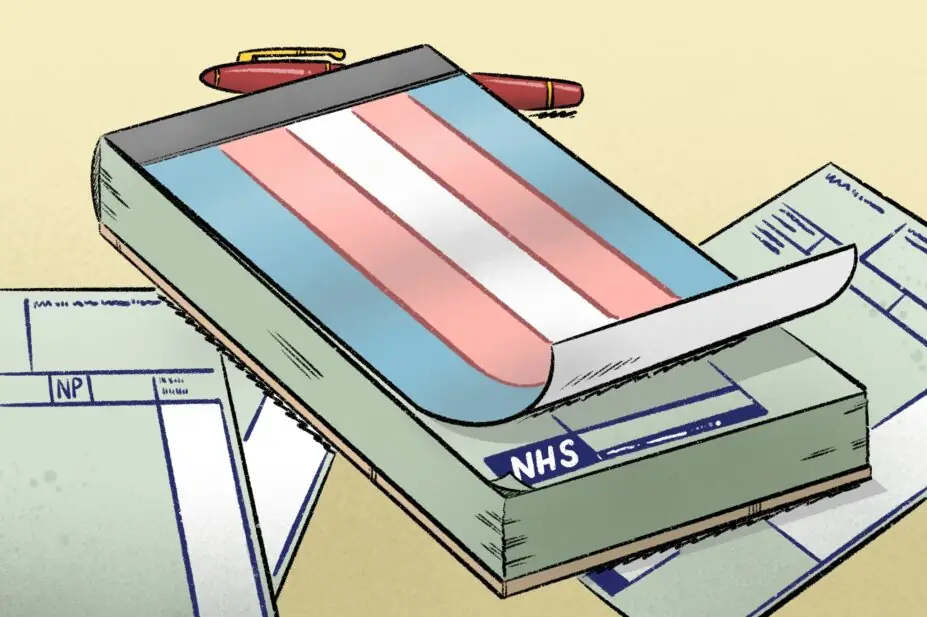
Wes Mountain/The Pharmaceutical Journal
Much like sexual orientation before it, transgender identity is on the slow but necessary path to depathologisation. Previously considered a mental or sexual health disturbance, we now recognise that being transgender or gender-diverse is a feature of the human experience that affects at least 1% of the population1–4.
Communities around the world have socially and culturally reinforced the reality of gender diversity, including India, Mexico and Canada, which recognise the hijras, the muxe and the two-spirit people, respectively5–7. Not only are these identities acknowledged; in some cases, they have legal protection. These gender-diverse communities have existed for centuries, challenging the erroneous assumption that to be transgender is a novel social phenomenon.
However, if transgender people are not new, why the sudden rise in disclosure? A common comparator used to describe this rise in visibility is with those who are left-handed8. Left-handedness was previously stigmatised, having been associated with ‘evil’, with children forced to learn to use their right hands, along with a right-handed bias in the design of everyday items. This is a succinct example of how pathologisation and negative social attitudes can result in the underreporting of natural human diversity. Just like with left-handedness, as social attitudes become more accepting, disclosure will rise before eventually reaching a plateau9. With the recent rise in the visibility of the transgender community in the UK, it is incumbent on us to reflect upon our healthcare systems and recognise where they may be limiting patient safety and outcomes.
Unintentional barriers
An example of a systemic barrier within the NHS that commonly affects transgender people is the single marker used to record both sex registered at birth and gender identity — two factors that can differ in those who are transgender. Understanding the roles of both gender and sex in patient health is important for our ability to address interpersonal, social, physiological and medical aspects of care. However, the NHS lacks a routine method of transgender status monitoring and, even if the data were opportunistically collected, many current NHS systems would not be able to record or use it effectively.
As the NHS links particular blood work, care pathways and screening programmes to a patient’s gender on their record, the lack of transgender status monitoring can cause serious issues for patient safety. For instance, transgender men receive no invitations for cervical or breast screenings and transgender women can face issues when attempting to access a prostate-specific antigen test10. Furthermore, the lack of transgender status monitoring can limit the accuracy of our interpretations and calculations regarding medication safety11.
Until the NHS is able to reliably monitor and track transgender status, we will be unprepared for identifying, monitoring and supporting this population group
There is a need for transgender monitoring data on patient records to reliably report on trends in disease incidence, staging at diagnosis, patients in a pathway, toxicities, outcomes and other factors related to patient experience and safety. Evidence from NHS surveys show that transgender patients have poorer experiences with cancer care12. However, these data alone are limited in their ability to advance change in the system at large, as these surveys reach a relatively small sample of transgender respondents.
Until systemic change is achieved, there is a burden on both the patient and healthcare professionals to overcome these barriers to care. However, the majority of people working in cancer do not feel knowledgeable enough in LGTIBQ+ healthcare, commonly resulting in transgender people educating professionals during their appointments13. To ease this burden, more high-quality education for healthcare professionals oriented to patient safety is needed.
One such example is our recent ‘TRANScribing’ resource, introduced to address the safe prescribing of anti-cancer therapies in patients on gender-affirming hormone therapy (GAHT)14. This resource has also been expanded upon to include other health considerations beyond the cancer space11.
Person-centred care
Our TRANScribing resource includes a focus on the concept of person-centred care, exploring inclusive communication for transgender patients and recapping these in quick reference flowcharts14. Fundamentally, person-centred care encourages healthcare professionals to build rapport and gather a holistic picture of a patient’s needs. Often, this needs to be done quickly and under work pressures that do not allow for extended consultations. It is complicated further by the current social climate, which has led to transgender patients feeling less safe, less trusting and unable to discuss their concerns12. To support the individual healthcare professional, the TRANScribing resource also cites the importance of using wider networks to support patient safety, including the specialist TransPlus UK Cancer and Transition Service15.
The concept of person-centred care is included as one of the General Pharmaceutical Council’s nine ‘Standards and guidance for pharmacy professionals’16. In particular, the standards state that pharmacists should “take responsibility for ensuring that person-centred care is not compromised because of personal values and beliefs16”. This is a powerful reminder to us as healthcare professionals that it is our duty to meet patients where they are at so that we can provide optimal patient care and safety.
This concept can be applied to the use or desired use of hormone therapies in transgender patients. Although GAHT may seem novel or complex, it can bear similarities to other aspects of patient prescribing that may be more familiar. For example, feminising GAHT may include the use of gonadotropin-releasing hormone analogues and anti-androgens, bearing similarities to androgen deprivation therapy used in prostate cancer17. This similarity has even been shown to reduce prostate cancer risk in transgender women receiving feminising GAHT18.
It should be noted, however, that owing to the incredibly long waiting times at NHS gender identity clinics (see Table), some patients may opt to privately procure their hormonal care. As a result, this hormonal therapy may not be accurately recorded in their patient record and may, in some cases, differ from standard NHS protocols17. This demonstrates the importance of building an open dialogue in healthcare in the interests of patient-centred safety and care.
Where do we go from here?
Sadly, the inequity faced by the transgender population continues to fly under the radar, despite evidence of numerous systemic and interpersonal barriers. Even in the recent Lord Darzi ‘Independent investigation of the NHS in England’, there was no mention of LGBTIQ+ issues in healthcare experiences, access or safety19. It is time to bring our community out of the shadows and support our call to be counted and heard.
The healthcare system must change to reduce the burden on both the patient and the healthcare professional. Transgender people have suffered long enough in battling a system that is systemically resistant to their inclusion and, thus, safe care and management. Until the NHS is able to reliably monitor and track transgender status across patient records in a way that is both functional and protects patient privacy, we will be unprepared for identifying, monitoring and supporting this population group.
Alongside the rise in the visibility of transgender people, we have also seen the development of a broader sense of gender diversity, including non-binary people. In these patients, GAHT desire and use may differ to that of transgender men and women20,21. As a result, we must be mindful to not only include this population in our progress, but also interpret studies on the effects of GAHT on the body with a personalised-care lens to appreciate the individuality of the initiation date, dosage schedule and drugs in use for each trans or gender-diverse person.
Ultimately, it is time to recognise that trans-inclusive care is person-centred care, and therefore the outcomes and safety of this population are everyone’s responsibility.
- 1.ICD 10: Gender Identity Disorders. World Health Organization. Accessed October 2024. https://icd.who.int/browse10/2016/en#/F64
- 2.Gender incongruence and transgender health in the ICD. World Health Organization. Accessed October 2024. https://www.who.int/standards/classifications/frequently-asked-questions/gender-incongruence-and-transgender-health-in-the-icd
- 3.Gender identity — Census Maps. Office for National Statistics. Accessed October 2024. https://www.ons.gov.uk/census/maps/choropleth/identity/gender-identity/gender-identity-8a/gender-identity-the-same-as-sex-registered-at-birth
- 4.GP Patient Survey — Analysis Tool. GP Patient. Accessed October 2024. https://gp-patient.co.uk/analysistool
- 5.Biswas S. How Britain tried to ‘erase’ India’s third gender. BBC News. May 2019. Accessed October 2024. https://www.bbc.com/news/world-asia-india-48442934
- 6.The muxe, Mexico’s ‘third gender,’ are part of a worldwide LGBTQ+ movement. Los Angeles Times. January 2024. Accessed October 2024. https://www.latimes.com/world-nation/story/2024-01-11/muxe-third-gender-isthmus-tehuantepec-mexico
- 7.Williams W. The ‘two-spirit’ people of indigenous North Americans. The Guardian. October 2010. Accessed October 2024. https://www.theguardian.com/music/2010/oct/11/two-spirit-people-north-america
- 8.Gilbert AN, Wysocki CJ. Hand preference and age in the United States. Neuropsychologia. 1992;30(7):601-608. doi:10.1016/0028-3932(92)90065-t
- 9.McManus IC. The history and geography of human handedness. Language Lateralization and Psychosis. Published online April 16, 2009:37-58. doi:10.1017/cbo9780511576744.004
- 10.Ma SJ, Oladeru OT, Wang K, et al. Prostate Cancer Screening Patterns Among Sexual and Gender Minority Individuals. European Urology. 2021;79(5):588-592. doi:10.1016/j.eururo.2020.11.009
- 11.Best practice principles for inclusive care of transgender and non-binary patients. Pharmaceutical Journal. Published online 2024. doi:10.1211/pj.2024.1.325943
- 12.NHS Cancer Patient Experience Survey. NHS England. Accessed October 2024. https://www.england.nhs.uk/statistics/statistical-work-areas/cancer-patient-experience-survey/
- 13.Berner AM, Hughes DJ, Tharmalingam H, et al. An evaluation of self-perceived knowledge, attitudes and behaviours of UK oncologists about LGBTQ+ patients with cancer. ESMO Open. 2020;5(6):e000906. doi:10.1136/esmoopen-2020-000906
- 14.TRANS:cribing. OUTpatients. Accessed October 2024. https://outpatients.org.uk/transcribing
- 15.UK Cancer and Transition Service. We are TransPlus. October 2024. https://www.wearetransplus.co.uk/uk-cancer-and-transition-service/
- 16.Standards for Pharmacy Professionals. General Pharmaceutical Council. 2017. Accessed October 2024. https://assets.pharmacyregulation.org/files/standards_for_pharmacy_professionals_may_2017_0.pdf?VersionId=C8dRrU1opDLdsuveSss5cKsPSwKObTi2
- 17.Information for health professionals for our gender identity clinic. Tavistock and Portman. August 2024. Accessed October 2024. https://tavistockandportman.nhs.uk/services/gender-identity-clinic-gic/information-for-health-professionals
- 18.de Nie I, de Blok CJM, van der Sluis TM, et al. Prostate Cancer Incidence under Androgen Deprivation: Nationwide Cohort Study in Trans Women Receiving Hormone Treatment. The Journal of Clinical Endocrinology & Metabolism. 2020;105(9):e3293-e3299. doi:10.1210/clinem/dgaa412
- 19.Darzi A. Independent Investigation of the NHS in England . UK government . 2024. Accessed October 2024. https://www.gov.uk/government/publications/independent-investigation-of-the-nhs-in-england
- 20.Kennis M, Duecker F, T’Sjoen G, Sack AT, Dewitte M. Gender Affirming Medical Treatment Desire and Treatment Motives in Binary and Non-Binary Transgender Individuals. The Journal of Sexual Medicine. 2022;19(7):1173-1184. doi:10.1016/j.jsxm.2022.03.603
- 21.Skorochod R, Rysin R, Wolf Y. Gender affirming surgery in non-binary patients: The importance of patient-centered care. Journal of Plastic, Reconstructive & Aesthetic Surgery. 2023;84:176-181. doi:10.1016/j.bjps.2023.05.050
1 comment
You must be logged in to post a comment.


Nobody can argue against personalised care, but the real gender problem with pharmaceutical care is lack of attention to differences between genders/sexes.
For example, there are meaningful and marked differences between asthma experiences in males and females. After the age of around 12, death rates, severity of attacks and hosptalisation rates are higher in females, management needs to reflect different phases of pregnancy and many females experience different risks of attacks in different parts of the menstrual cycle. Do pharmacists counsel patients on this? Do girls approaching the menarche get advised that their asthma experiences and risks of attack may change? Likewise women approaching the menopause? If we don't, we should.
For asthma, the reason for the differences are not fully understood, but they are certainly in part related to sex hormone changes. There may, though, but be other issues - perhaps resulting from XY versus XX chromosomes, and it may vary with the type of asthma.
There will be plenty trans men and trans women who need appropriate support because of hormone treatments they are receiving.
If UK healthcare paid more attention to gender differences in multiple areas that we currently ignore (the list of conditions is very long and awareness is arguably particularly low in the UK), it would automatically follow that the trans community would receive appropriate support.
Because of the scale of the problem (i.e. affecting everyone), I would argue that it is awareness of healthcare differences between males and female that needs attention first with attention to the needs of trans individuals immediately building on that.